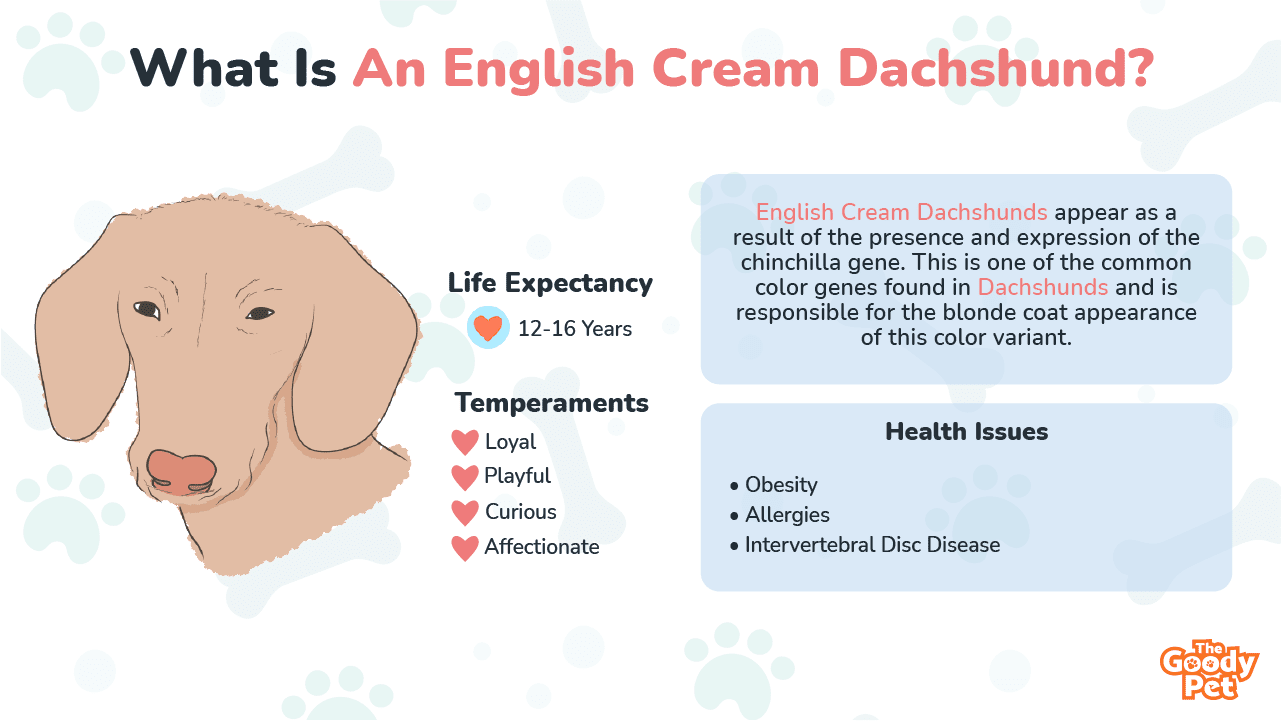Dachshunds are incredibly diverse when it comes to appearance.
From dapples to pure reds, the one thing they all have in common is the fact that they are incredibly cute. One of many dog owners’ favorites is the English Cream Dachshund. Also known as blondie doxies, these dogs are similar to the miniature sausage silhouette version of a golden retriever, and there are fewer things on the planet that can be even more adorable.
However, due to the rare nature of these dogs, they are not very well understood and are commonly confused for other variants, including the clear cream doxies.
The English Cream Dachshund is a type of Dachshund identified by the cream or golden brown color of their coats. It is due to the expression of the recessive chinchilla gene that is also known as the blonde gene.
It mainly affects Dachshunds with red coats and spares brown or black ones. Other than the difference in coat color, the temperament, build, and health status of an English cream are the same as those of regular Dachshunds.
Despite being predominantly UK-based for a long time, these adorable doxies are popular on a global scale. Let us take a look at what makes them so unique and why you might want to consider getting one of your own.
What Is An English Cream Dachshund?

English Cream Dachshunds appear as a result of the presence and expression of the chinchilla gene. This is one of the common color genes found in Dachshunds and is responsible for the blonde coat appearance of this color variant.
The gene itself is recessive, which means that two copies, one from each parent, are needed for it to manifest.
The gene results in a lack of pigmentation. It mainly affects red coat bases on Dachshunds and spares black and brown-haired doxies, and the result is the signature cream coat.
Occasionally, the dog may have dark bands at the tips of its fur. This usually happens on the fur around the head.
One of the main clues that you are dealing with an English Cream Dachshund is the fact that they are always born dark-colored. They may appear black, brown, or red, but in a real sense, they are all red-haired. Over time, they lose pigmentation, with new fur growing out as a cream and not red. The tips may retain their darker colors.
Another distinguishing feature about this dog is the long and smooth coat that they all have. This is unlike regular doxies, which have a variety of coat textures and lengths, including long and wiry as well as short and fine.
Other than the coat color and texture, the English Cream Dachshund is more or less the same as any other doxie. They have the same sausage dog silhouette with a long body and short legs.
However, it is not uncommon to find them smaller than regular doxies. The average weight of an English Cream Dachshund is 14 lbs which fall lower than the typical range of other Dachshunds between 16 lbs to 30 lbs.
How About Cream, EE Cream And Shaded Cream Dachshunds? What Are Their Differences With The English Cream Dachshund?

There is a lot of confusion when it comes to identifying and adequately classifying Dachshunds with blonde fur. There are four terms that are often thrown about in this case.
These are English Cream, Cream, EE Cream, and Shaded Cream.
English Cream Dachshund
We have already discussed this one in-depth. It is caused by depigmentation that is triggered by the chinchilla gene. They are born dark-colored and become blonder over the years.
EE Cream Dachshund
This variation is associated with the EE-red gene. Unlike the chinchilla gene, this one makes the Dachshund incapable of producing any dark pigment. They are born cream-colored and, in addition to the fur, also have cream nails and whiskers.
Shaded Cream Dachshund
This is a term used to refer to a Dachshund with cream fur and dark banding on the tips of the fur. Strictly speaking, it is exactly the same as an English Cream Dachshund and is only distinguished by the presence of the retained dark banding. Like the English cream, the paw pads, nails, and whiskers may be dark in color, which is an excellent way of distinguishing them from the EE-cream doxies.
Cream Dachshund
This is yet another blanket term used to refer to pretty much all cream-haired doxies. This includes the English cream and the EE cream doxies. It doesn’t matter what the genes responsible are in this case.
Do English Cream Dachshund Shed? Grooming Tips For The English Cream Dachshund
Like all other regular Dachshunds, the English Cream Dachshunds are not hypoallergenic. They are actually considered moderate to heavy shedders depending on how often you trim their fur.
This is mainly because of the long and smooth nature of their coat. This means that they need a lot more care when it comes to grooming, especially if you are dealing with allergic family members or guests.
One of the most important grooming practices when dealing with English Cream Dachshunds is regular brushing. This helps to get rid of any loose hair and therefore reduces the overall amount of shedding that you may have to deal with. With these doggies, brushing 2 to 3 times every day should be enough to make your life easier.

It is also important to factor in the cream color of the coat when planning out your grooming routine. As a lighter-colored coat, it stains easily, and it is easier to tell if the dog is dirty. So make sure to wash the doxie on a regular basis, in which case an interval of 1 to 2 times a month should be enough.
In addition to regular washing, you should opt for shampoos with whitening features. The Lillian Ruff Brightening & Whitening Shampoo for Dogs is a fantastic option worth checking out in this case. It helps with odor control, conditions the fur, and keeps the blonde shades shiny and healthy-looking.
Finally, note that English cream doxies tend to have sensitive skin. As a result, avoid cleaning products with harsh compounds like parabens and alcohol.
What Is The Temperament Of An English Cream Dachshund?
For the most part, English Cream Dachshunds are just like any other doxie when it comes to personality. However, owners have described them as being particularly sweet and calmer than their regular counterparts.
Affectionate
English Cream Dachshunds are popular as family pets mainly because of their loving nature. Once they get to know you and trust you, they will be incredibly affectionate. They love to cuddle and play with their families and are generally really good to have around if you want that kind of energy.
Loyal
Like regular doxies, these beautiful blonde beasts have a close relationship history with their human masters. They are loyal and protective to a fault. It is for this reason that they were so popular in the UK, where they were used as guard dogs and hunting dogs.
Curious
English cream doxies are also known for being very curious. They love to explore unfamiliar spaces, whether it is that room you never let them into or a new park that you take them to. While this is cute, beware of their potential for mischief as they go on their little discovery expeditions.
Playful

These furry little buddies love nothing more than playing and staying active in general. They love large spaces where they can run around and feel free. However, they are also ideal if you have small spaces, and a game of fetch or hide and seek in the apartment will satisfy them just as well.
Mistrusting Of Strangers
It takes an English cream a little while to warm up to strangers. They may even bark at or attack unfamiliar people if they feel threatened. The best way to deal with this is to socialize them from an early age.
What Are The Common English Cream Dachshund Health Problems?
The chinchilla gene is not associated with any specific health issues. As a result, English Cream Dachshunds only suffer from health problems that affect regular doxies. They also enjoy the breed’s long lifespan of 12 to 16 years.
Here are some of the health conditions you may have to deal with raising an English Cream Dachshund:
Obesity
English Cream Dachshunds are known for their heavy appetite. They are therefore at risk of developing obesity as a consequence of overeating. It is made worse by any conditions that could affect motility, which is particularly common with miniature English Cream doxies.
Allergies
Like regular weenies, this color variant is also at risk of developing a wide range of allergies throughout their lives. These include reactions to things like dust, mites, pollen, chemicals, and some fabrics. They tend to cause contact dermatitis or respiratory reactions.
Cancer
This is a disease of old age with English Cream Dachshunds. They are particularly prone to skin cancers like melanomas. Others include hemangiosarcomas and tumors of the gut and reproductive system.
Intervertebral Disc Disease
IVDD is particularly common with miniature English cream doxies. The back problems result in extreme pain and, in the worst cases, may even result in complete paralysis of the dog.
Hip And Knee Joint Problems
These dogs also suffer from skeletal issues like hip dysplasia and patellar luxation, which negatively impact mobility and overall quality of life. You could help your doggy by giving them supplements like the Zesty Paws Hip & Joint Mobility Bone Broth. This contains compounds like Chondroitin, glucosamine, and collagen, which help promote bone and joint health.
Related Questions
What Is An EE English Cream Dachshund? This is a type of Dachshund that has the EE-red gene. It is common when two Dachshunds with the recessive chinchilla gene breed. The dog is born with cream fur, which distinguishes them from regular English Cream doxies. They also have cream whiskers and nails, which is how you tell them apart from other blonde doxies as adults.
What’s The Difference Between Cream And English Cream Dachshund? The Cream Dachshund is a group of doxies with blonde fur. This includes everything from EE clear cream doxies to the traditional English cream variety. The English Cream Dachshund, on the other hand, stands out with the presence of the Chinchilla gene. They are born darker and slowly develop a cream coat.
How Much Are English Cream Dachshunds? An English Cream Dachshund costs about $1,500 when bought from reputable breeders. They are relatively rare, which is why they can be so expensive. Despite being so expensive to purchase, they are relatively cheap to maintain, and they should not cost you more than $650 per year unless you are dealing with a sickly doxie.





